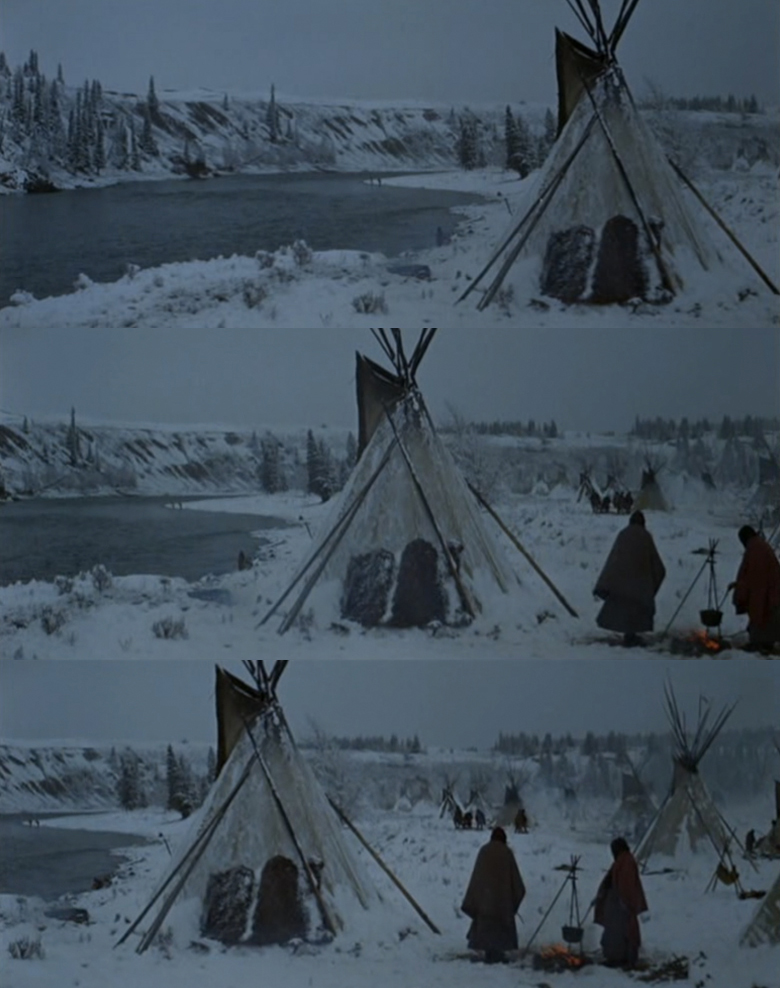Alberta’s magnificent landscape has served as a popular backdrop for many well-known Westerns, many of them partially or fully filmed on the Morley reserve, featuring members of the Stoney Nakoda First Nation as cast and crew.
Despite the Stoney Nakoda’s visible contribution to Alberta’s film history, there has been little documentation of their involvement with the creation of these media texts, a societal failure that researcher Mary Graham and the Stoney Nakoda themselves are now endeavouring to correct with a series of ongoing Western screenings on the Stoney Nakoda reserve. This series, officially titled “First Nations Involvement in Alberta’s Film Industry: An Oral History of the Importance of Stoney Nakoda Influences in the Last Century,” provides an intimate space where elders and community members can identify ancestors, horses, locations, and family members from films from throughout Alberta’s history. The films screened range across the decades and include Until They Get Me (1917), Canadian Pacific (1949), 49th Parallel (1941), Buffalo Bill and the Indians (1976), Saskatchewan (1954) and Little Big Man (1970), among others. The outpouring of support for the urgency of this project has been immense, both from the government and from the Stoney Nakoda community and elders. As many of these Alberta-shot films are rare and rapidly growing in age, the need to officially document Indigenous involvement in these early moving pictures was and is pressing.
The screening of Little Big Man was scheduled to start at 10 a.m. this January 13th on the Stoney Nakoda reserve. The sun had just risen, and glowed orange on the frost-covered slopes of the Albertan foothills. Nearing the reserve, one hour west of Calgary, the bare hills transitioned into green tree-covered peaks etched with streams running alongside and under the highway. One can easily see how the landscape in this area has drawn filmmakers into Alberta for almost 100 years, and continues to make it a popular filming location.
The screening room was packed, with around twenty individuals gathered to watch the film. Of these twenty were several elders representing the three bands which make up the Stoney Nakoda First Nation—Chiniki, Wesley, and Bearspaw. The chairs were set up in a three-quarters circle, with the projector and film completing the ring. The assembly participated in a group prayer to start, intensifying the sense of intimacy in the already close screening space. Little Big Man, filmed in both Montana and Alberta, used Montana primarily for town sequences and the climactic Little Bighorn battle scenes, and Alberta for its wild outdoor backdrop. Graham played the selected film, pausing whenever an elder or other participant recognized a member of their band or a specific geographic location.
Nearing the reserve, one hour west of Calgary, the bare hills transitioned into green tree-covered peaks etched with streams running alongside and under the highway.
The most common type of identification found in media spectatorship is the viewer identifying with a character, storyline or movie star. The type of identification found at this screening of Little Big Man was profoundly different—the elders and other viewers expressed identification with geographic spaces, and with members of the cast that they knew personally. This unique form of spectatorship intertwined the intimate and communal. Laughter and discussion filled the room. Family and friends were instantly identified with combined murmurs of agreement in the group. Individuals shared their stories of the film not on a narrative level, but on a deeper, personal, and historical plane.
The group mutually recognized Dick Amus, Charlie Simeon, Noah Goat, and Jake Rabbit in the first hour. The ‘Snakewoman’ in Little Big Man, who helps heal Crabb and prepares Old Lodge Skins (Chief Dan George) for death in the film’s climax, was identified as Edna Simeon, who passed away in 2008. A female elder excitedly pointed out her mother and her mother’s best friend during a snowy winter sequence filmed in Morley; her mother told her about being in the film years ago. Two other elders, sisters Kathleen Pouchette and Clarice Kooteney, identified their sister, Cecilia Kootenay, who had had a pivotal role in the film as Little Elk, one of Jack Crabb’s (Dustin Hoffman) four wives. Since deceased, Cecilia was only fifteen when she was cast in Little Big Man, a role requiring Cecilia and her mother to travel to Hollywood for four days to film scenes between Little Elk and Crabb. Shot in lush Technicolor, Little Big Man may be the only moving picture record of fifteen-year-old Cecilia. The group laughed together at her sisters’ recollection that “she had fun” filming the love scene. The banks of the Bow River inside the Stoney Nakoda reserve were instantly recognized in a winter sequence—a popular spot for filming, the group said. That exact curve in the river has been featured in multiple Hollywood films.
When Graham asked if anyone recognized the clothing, face paint, horses, or patterns on the teepees in Little Big Man, the elders agreed that these costumes and props were added by Hollywood, and were not part of their heritage. The largest amount of laughter occurred at the film’s climax, where Old Lodge Skins prepares for death. Filmed on the Stoney Nakoda reserve, Old Lodge Skins, accompanied by Crabb, ascends a massive hill facing the sun and proceeds to sing and dance. When Graham paused the film on this climactic shot and asked the group if they recognized the song, the group of elders burst into laughter, saying that the song was added by “Hollywood,” chuckling at the absurdity of the tune. While many of the films screened demonstrate similar culturally ignorant assumptions, Graham said that a majority of their gatherings have been incredibly positive experiences, describing the day they screened Buffalo Bill and the Indians as one of the best days of her life, filled with laughter as the elders recognized subversive inside jokes spoken in the Stoney Nakoda language in the film. The same experience occurred during Saskatchewan, where Chief Walking Buffalo—a Bearspaw Chief and world-travelling activist for peace—tells a group of extras on-screen during a serious sequence, “Don’t laugh, the cameras are rolling.”
Laughter permeated sections of the screening, where a deep and profound sadness soaked into others. At one point in Little Big Man, General Custard and his army slaughter Jack Crabb’s friends and wives, including Little Elk and her infant son. Watching the (fictional) massacre of personal family members—including Cecilia and her character’s infant baby—proved challenging for many members of the group. Mina and Charles Powderface, two elders of the Chiniki band at the screening, revealed to the group that their two-and-a-half month-old daughter played the on-screen role of Crabb’s son. When it came time to view the massacre sequence, Graham offered to skip over the scene. Many of the group chose to sit through it, while others chose to leave. Of the ‘bodies’ lying on the ground in the film, the collective group identified Joyce Pouchette, Wallace Ear, and six-year-old Wesley Beaver. These personal identifications continued to fuse collective and personal spectatorship, as the room held the weight of mass atrocities committed against Indigenous persons in North America throughout history and now, as well as intimate personal connections to those atrocities brought up by seeing family and friends mimetically ‘killed’ on-screen.
Records show that many prominent directors, such as Robert Altman and Michael Powell, sought to work in Alberta for the Stoney Nakoda people who, based on Mary Graham’s historical research, have been considered “highly skilled, fearless professionals” for generations: stuntmen, set builders, mountain guides, location scouts, wranglers, extras, and actors, even dating back to the silent years of cinema. A prime example of this is The Valley of the Silent Men, filmed on and around the Victoria Glacier in 1922, where the film’s dangerous and dynamic stunts—such as lowering the main actress into crevasses in the glacier—were only made possible by the Stoney Nakoda’s positioning within both the cast and crew.
Mary Graham’s collaborative screening series and successive upcoming book The Stunning Backdrop: A Century of Alberta Landscapes in the Movies show us an alternative, realistic history of film. While the Stoney Nakoda’s role has been overlooked in conventional ignorant surveys of Canadian film and film history more broadly, their formative presence in American and Canadian film history remains. By drawing attention to personal and communal oral accounts of these important records, Graham juxtaposes a new account of Alberta film history with the old and inaccurate, revealing the dynamic, intimate, humorous relationship between the Stoney Nakoda community, and Alberta’s film history.





